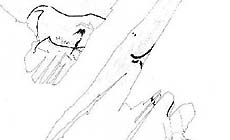 |
Description: |
Engravings
Paintings
Painted engravings
High or low-relief
Sculpture
Na parte superior desta rocha, observa-se uma pequena porção da linha cervico-dorsal e a cauda, assim como parte da perna traseira, de um caprino disposto na horizontal e voltado para a direita. Completo, seria um animal de grandes dimensões, gravado na parte mais elevada do painel. Foi aberto por picotagem profunda. A cauda apresenta dois traços paralelos e a perna tem perfil em V. Abaixo desta figura descobre-se um conjunto de gravuras filiformes. Junto ao bordo, reconhecem-se a cabeça e o pescoço de um quadrúpede, talvez um equídeo, voltado para a direita. Apresenta cabeça longa, com linha de testa algo curva e linha mandibular recta. A extremidade do focinho é arredondada. Sobre a testa observa-se uma orelha, de forma lanceolada, alta. Da linha cervico-dorsal só foi representado o arranque, e tanto o interior da cabeça como o peito se encontram preenchidos por traços filiformes. À esquerda identifica-se uma figura de quadrúpede, de espécie indeterminada, obtida através de uma simples linha de contorno. Mostra uma linha de testa ligeiramente curva, linha mandibular quase recta e extremidade do focinho apontada. A linha do peito é recta. Sobre esta figura reconhece-se um conjunto de traços filiformes, que sugerem uma figura de tipo pisciforme. Outros traços filioformes, dispostos na vertical, na horizontal ou oblíquos, não constituem figuras reconhecíveis.
|
Figures: |
total number 3
Figuras zoomórficas (caprino, quadrúpedes indeterminados)
|
|
 |
Chronology: |
Palaeolithic
Epipalaeolithic - Mesolithic
Neolithic
Copper Age
Bronze Age
Iron Age
Roman
Middle Age
Modern
Unknown
|
Notes: |
Abstract: Penascosa is one of the most remarkable Rock Art sites of Vale do Côa Archaeological Park. It's an open-air site, that combines a great number of engraved rocks. These engravings were made by pecking, scratching and abrading techniques, and combination of some of these. In the context of Vale do Côa Rock Art, Penascosa is one of the three biggest nucleous, together with Quinta da Barca and Canada do Inferno sites. In Penascosa are represented engravings dating from all palaeolithic epochs, namelly rock 3, which presents a long figure stratigraphy, animated figures, and a rare mothif of palaeolithical rock art: a fish representation. It's visible a rare technique, made by surface abrading. There are also engravings dated from Neolithic and Iron Age. |
|
 |
 NEW: Alpine rock paintings
NEW: Alpine rock paintings
